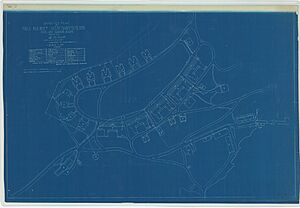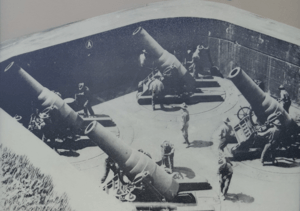Fort McKinley (Maine) facts for kids
Quick facts for kids |
|
|
Fort McKinley Historic District
|
|

A 12-inch disappearing gun, like those at Fort McKinley
|
|
| Location | Great Diamond Island, Maine |
|---|---|
| Area | 43 acres (17 ha) |
| Built | 1897 |
| Architect | US Army Corps of Engineers |
| NRHP reference No. | 85000611 |
| Added to NRHP | 21 March 1985 |
Fort McKinley was a United States Army fort built to defend the coast. It was located on Great Diamond Island, Maine, in Casco Bay. The fort was active from 1873 to 1947. It was named after President William McKinley.
A smaller fort, Fort Lyon, was part of Fort McKinley. It was located nearby on Cow Island and named after Nathaniel Lyon. Both forts helped protect the important port and naval area of Portland, Maine. This protection lasted from 1895 to 1950. Fort Lyon closed in 1946 and was given to the City of Portland. After Fort McKinley closed, it was transferred to the United States Navy. Later, in 1961, it was sold to private owners. The Fort McKinley Historic District was added to the National Register of Historic Places in 1985.
Contents
History of Fort McKinley
Building the Forts
In 1885, a group called the Board of Fortifications suggested building many new forts. Forts McKinley and Lyon were two of these projects. Construction on Fort McKinley started in 1897 and finished by 1906. The fort covered about 111 acres. It was split into two parts by Diamond Cove.
Cow Island was bought by the government in 1873. Fort Lyon was built there on 22 acres and finished by 1909.
Fort McKinley's Big Guns
By 1906, Fort McKinley had nine gun batteries. These batteries held different types of large guns. Some were 12-inch mortars, which fired shells high into the air. Others were 12-inch and 8-inch guns that could disappear after firing. This made them harder for enemy ships to hit. There were also 6-inch and 3-inch guns. The 3-inch guns were used to protect underwater minefields.
Fort Lyon was completed by 1909. It had two gun batteries with 6-inch and 3-inch guns. These guns also helped protect the minefields.
The forts also had many buildings for soldiers. Barracks were built for soldiers to live in. There were also homes for officers and non-commissioned officers (NCOs). Other buildings included a hospital and a guardhouse. The forts were expanded over time to hold more soldiers.
Forts During World War I
During World War I, soldiers from the United States Army Coast Artillery Corps and the Maine National Guard manned the forts. After the United States joined the war in 1917, some guns were removed. They were meant to be sent to the Western Front in France.
For example, some 12-inch mortars were taken out. This was because having too many in one pit made reloading difficult. Some 8-inch guns were also removed but never left the fort. They were later put back. Some 6-inch guns were sent to France but returned to the U.S. after the war. None of these large guns saw action in France.
By 1920, Fort McKinley's 3-inch guns were removed. They were considered old and no longer useful.
Forts During World War II
In 1940-1941, both forts were expanded again. This was because many new soldiers were joining the army due to the draft for World War II. Fort McKinley added temporary barracks, mess halls, and recreation buildings. This allowed the fort to hold many more soldiers. Fort Lyon also added new buildings and a wharf. An antiaircraft battery was also placed there.
However, by the end of 1943, most of the old guns were removed and scrapped. The defense strategy changed, focusing on newer, more powerful batteries like Battery Steele on Peaks Island. Only a few guns remained at Fort McKinley and Fort Lyon. By 1944, there was little threat to the East Coast from enemy ships. The forts were no longer as important. Soon after the war, the Army left Forts McKinley and Lyon. The properties were then sold or transferred.
Fort McKinley Today
Today, Fort McKinley has been turned into a private community called Diamond Cove. Most of the old gun batteries are covered by plants and are on private land. Cow Island, where Fort Lyon was, became a camp in 2000. This camp focuses on environmental, adventure, and leadership programs.






